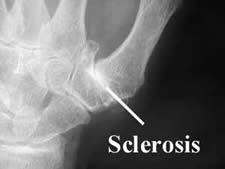Osteoarthritis
What is osteoarthritis?
 |
 |
Patient with osteoarthritis of the hand, clinical photo on left, same patient's xrays on right. |
|

Osteoarthritis is inflammation (redness, swelling, and pain) of the joints. It is very treatable, and that is the most important thing to remember as you read this site.
Osteoarthritis is rarely deforming or crippling, although it can be painful if not treated. The deforming and crippling arthritis is rheumatoid arthritis, which is a very different disease.
Osteoarthritis is very common and affects almost everybody as they get older. The older you get, the more likely you are to have it, and around eight out of ten people over the age of 50 are affected. In the hand, it typically affects the base of the thumb first (see the image above and the xray at right), then the finger joints. Women are affected more than men. Note in the xray at right that the thumb base joint is narrow, with almost no cartilage left, and the two bones are rubbing against each other.
Osteoarthritis can be thought of as "wear and tear" arthritis. It is not the same as rheumatoid arthritis, which is an autoimmune disease in which your body thinks that you are allergic to your joints. Rheumatoid arthritis is very deforming and can be crippling. Osteoarthritis does not deform the hands in the way that rheumatoid arthritis does .
More Severe Osteoarthritis
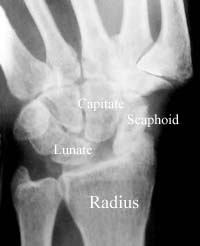
This patient has more severe osteoarthritis. The base of the thumb metacarpal has with more whitening of (called "sclerosis"). Also, note how not only the thumb base joint is narrow, the radius-scaphoid joint space is very narrow, and the space between the lunate and the scaphoid is too wide (called "scapholunate diastasis"). There is some beginning narrowing of the joint between the capitate and the lunate.
Whenever the joint space is narrow, it means the cartilage on that joint is worn away (like bald tires imply that the tread is worn away).
Osteoarthritis can be thought of as "wear and tear" arthritis. It is not the same as rheumatoid arthritis, which is an autoimmune disease in which your body thinks that you are allergic to your joints. Rheumatoid arthritis is very deforming and can be crippling. Osteoarthritis does not deform the hands in the way that rheumatoid arthritis does .
In-depth Explanation of Osteoarthritis Xrays
If you want to see more xrays of arthritis, read this section. If you want to move on to what osteoarthritis is, skip to the next section on symptoms.
 |
 |
 |
| Click images to view larger versions and additional text | ||
What is osteoarthritis on a microscopic level?
Osteoarthritis is wearing out of your cartilage. What is cartilage? It is the white, smooth, shiny material at the ends of your bones, it is the "ball bearings" that allows the joints to move smoothly. If you have ever cut up a chicken to fry it, you have seen cartilage: it is the white shiny material on the end of the bones.
Your cartilage is made of a rather large and complex molecule. I have drawn a representation of it here:
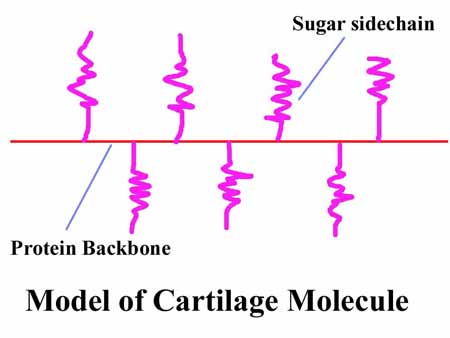
Here is what a real cartilage molecule looks like, in an electron microscope:
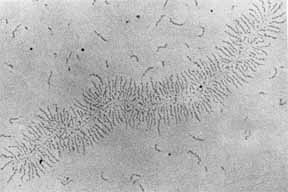
Here is what the cartilage in your joints looks like, in cross section. The joint surface is at the top and the bone is at the bottom. The round things are cartilage cells, and they produce the cartilage molecules. (Cartilage photomicrographs are some of the most beautiful of all histology slides!)

Osteoarthritis starts with biochemical changes in your cartilage. The sugar sidechains like water, and cartilage is a bit like a wet sponge. The water molecules squish out as we walk or press on our joints (with the water acting a bit like a lubricant), and seep back in when we take force off our cartilage. With age, we tend to lose some of the sugar sidechains, which changes the biomechanical characteristics of our cartilage (the sponge becomes less wet and therefore less resilient). It becomes stiffer and loses some of its self-lubricating ability. The result is that the cartilage starts to wear, becoming thin. The surface becomes rough; it is no longer a smooth bearing surface.
The photographs below show the changes in your cartilage as the sugar sidechains are lost. The photomicrograph on the left shows normal cartilage. The red material is the cartilage, the blue material (with holes like Swiss cheese) is the bone supporting the cartilage. On the right, you can see a roughening of the joint surface, with tears in the surface and pieces of cartilage breaking off in strands. There is also a crack in the cartilage, extending down into the bone. Over time, the cartilage can wear out completely, with bare bone in the joints.
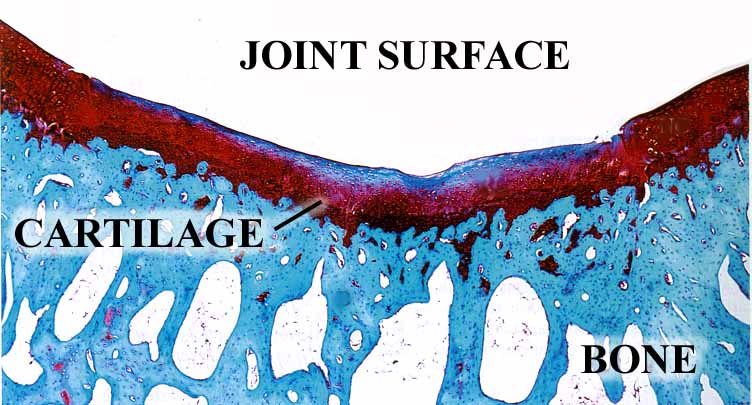
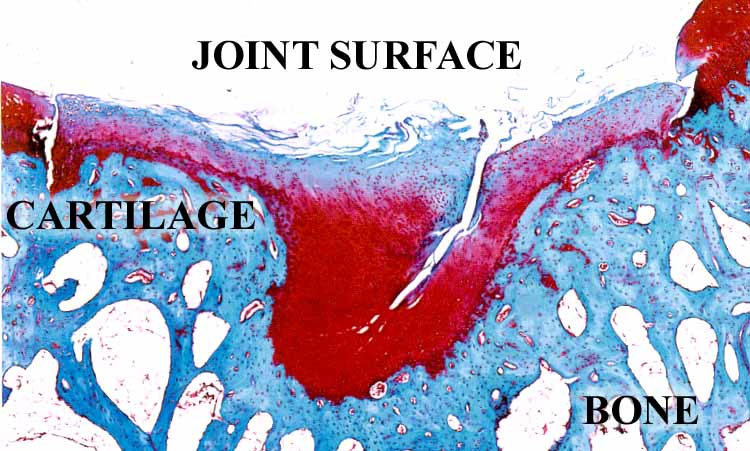
At the same time, many other changes are occurring. The joint capsule becomes thicker and more synovial (lubricating) fluid is manufactured which makes the joint swell. In addition to cartilage degeneration, the bone along the edge of the joint responds to the changing biochemical and biomechanical environment, growing bony ridges called osteophytes.
What does this mean in my joints?
 1 |
 2 |
 3 |
 4 |
 5 |
Click to view larger images with additional text ~ This series of images is from MedcoHealth |
||||
What are the symptoms of osteoarthritis?
The hallmarks of osteoarthritis are joint stiffness, swelling, and pain. This often improves with light activity, but is usually worse again after forceful gripping or pinching, or after a period of rest.
Who gets osteoarthritis?
Many people think osteoarthritis should come from a long history of hard work, but hard labor does not seem to be very related. Osteoarthritis can be due to trauma such as an old fracture, but it is usually just due to the effects of aging coupled with some hereditary contribution.
How is osteoarthritis diagnosed?
The diagnosis is made by listening to the patient and by examining the patient. Most patients will have a history of slowing increasing pain, stiffness, and swelling over a period of years. Sometimes there is a fairly sudden onset of symptoms, usually associated with a single episode of trauma (typically a fall) or a period of overuse (weeding the garden, say, or packing to move). An xray examination confirms the diagnosis. Often there will be no correlation between the amount of pain and the severity of the arthritis as shown by the xray.
What does the xray show?
The xray typically shows some joint space narrowing, that is, the white shape of the bones are closer together than they normally are (see the xray above). The bone along the joint is usually whiter (called "sclerosis") and may have little points of bone growing out (called "osteophytes"). There may be holes in the bone ( called "cysts") and the bones may be starting to slide out of alignment (called "subluxation"). I will review your xrays with you and explain exactly what I see.
 |
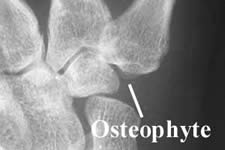 |
|
|
This patient has more advanced osteoarthritis. Note the complete loss of joint space (no space between the bones of the thumb), cysts (holes in the bone, shown as the small black areas in the base of the thumb metacarpal, which is the large bone on the upper left side of each view), large osteophytes, and some lateral subluxation (the thumb metacarpal has slid off to the left of the bone it touches, the carpal bone called the trapezium). More on the names of the bones here.
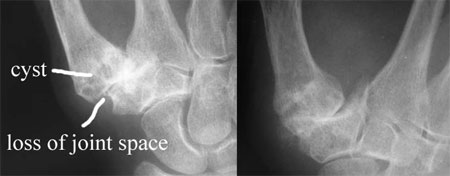 |
This patient has even more advanced osteoarthritis. Note the complete loss of joint space, the large osteophytes, the loss of the size of the trapezium, and the fact that the thumb metacarpal (the bone on the left in each image) has started to collapse toward the palm (see on the left image).
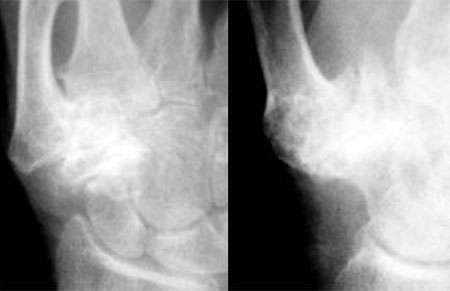 |
How is osteoarthritis treated?
Outline of My Treatment:
1. Diagnosis
2. Patient education
3. Activity modification
4. Medical Management
5. Steroid injection
6. Surgery
Patient Education
I believe that the key part of treating osteoarthritis is patient education, which is why I created this website and wrote this paper. Once the patient understands what is going on, they can take charge of managing their condition. Osteoarthritis cannot be made to go away; getting younger is the only thing that will do that (we are working on it!). Osteoarthritis is not "cured", but managed. Patient involvement in that management is key.
Activity Modification
The next step after patient education is activity modification. Learn what activities exacerbate your pain, and see if you can avoid them. For instance, opening tight jar lids puts a great strain on your thumb base joint. Get a plastic sheet from me when you see me, or ask someone else to open jars. If you have faucets that are leaky or stiff, replace the gasket or grease the threads. Look at the act ivies throughout your day and identify which ones cause you pain. There are many different kinds of pens around that allow you to write without upsetting your thumb base. Check out this link, it is a page I have written and illustrated showing you the many options available to avoid pain when writing.
Along with activity modification, there are a number of patient-directed therapies which can help. Pain can be relieved by applying heat to stiff and painful joints for 20 minutes up to three times a day. Various deep heat lotions, heating pads, infrared lamps, hot baths etc. can be used. Swimming in a heated pool can help.
Medication
I have placed my outline of the medication management for osteoarthritis here.
I have place information on anti-inflammatory medication and COX-2 inhibitors here.
There is some increased risk of heart attacks and strokes with all NSAID's. See the FDA's guide for patients to NSAID's.
If you have a history of stomach ulcers, COX-2 inhibitors such as Celebrex, may be better for you than simple NSAID's.
The medical management of arthritis is complex and you should read all of these pages and discuss with me what is right for you.
Steroid Injections
Steroid injections can be very helpful to calm down a very painful joint. These are not the systemic steroids that cause road rage, osteonecrosis, and all the other bad things you have heard about steroids. These are highly localized treatments of steroids, which are a class of substances that your own body makes to calm down unwanted or excessive inflammation. I am allergic to pain, and presume that you are, too. I have learned a technique that is virtually painless, and almost every patient tells me that the shots that I give are the best that they have every had. I mean it.
Surgery
Surgery is reserved for last. It is only for patients whose osteoarthritis is so bad that they cannot manage their disease with activity modification, anti-inflammatory medication, and steroid injections. Indications for surgery generally involve patients who are so miserable with their arthritis that they cannot do the things in life that they want to do. Life is too short to give up all the things you like to do. If you have tried all of the above steps, and still have more pain and more limitations than you want to live with, talk to me about surgery. Some procedures are fairly simple and some are more complex. I can outline all of your options when you come in.
The treatment options for each joint are different. The most common arthritis, at the base of the thumb, is treated by cutting off the last 3 mm of the metacarpal and the first 3 mm of the trapezium, then placing a tendon into the space, to act as a "rubber baby buggy bumper", preventing the bone ends from hitting each other, and thereby resolving the pain. The distal interphalangeal joint (DIP, the one next to the nail) of the fingers or the interphalangeal joint (IP joint, next to the nail) of the thumb, is fused. An clinical example is here.
Additional Resources
Osteoarthritis is common, and many physicians agree with me that patient education is key to empowering the patient to manage their own disease. Therefore there is a lot of additional information available for you. You can select from:
American Society for Surgery of the Hand: Patient Education Brochure: Arthritis of the Base of the Thumb.
Here is some additional information that I have written:
Celebrex and Vioxx, the COX-2 Inhibitors
Chondroitin and Glucosamine
There is a different kind of arthritis caused by silicone implants, called silicone synovitis. I have written a page on it, entitled Silicone Synovitis.
Here are some links you may want to examine. These are commercial sites, I have reviewed part of them (last time reviewed: June 4, 2000) and they seemed to be OK, but I am less sure of the accuracy of these sites than I am of the above sites. Let me know what you think of these.
General Arthritis Information:
Johnson & Johnson arthritis site called All About Arthritis

